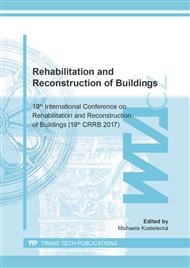p.59
p.66
p.70
p.76
p.81
p.86
p.92
p.98
p.104
Application of Acoustic Emission Method and Impact Echo Method to Structural Rehabilitation
Abstract:
The paper is concerned with the technical aspects of the appraisal and retrofitting process of fire damaged reinforced concrete structures. The assessment of fire damaged structures is carried out along lines similar to those of the appraisal of existing structures. In practice, constructions are most often assessed by destructive tests in-situ and on core bore specimens. In addition to destructive tests, damaged structures are also assessed by non-destructive ones. The present paper shows the use of non-destructive methods of measurement using the acoustic-emission and impact-echo methods. Acoustic emission provides valuable data on the structural integrity of a material. This method has a significant potential to be used for in-situ monitoring and evaluation of the current state of structures. An impact-echo method is based on impact-generated stress waves that propagate through concrete and are reflected by internal flaws and external surfaces. Impact-echo can be used to determine the location and extent of flaws such as crack delamination, voids, honeycombing and deboning in plain, reinforced, and post-tensioned concrete structures. The paper presents a possible rehabilitation plan based on the potential results obtained by these non-destructive methods.
Info:
Periodical:
Pages:
81-85
Citation:
Online since:
August 2018
Price:
Сopyright:
© 2018 Trans Tech Publications Ltd. All Rights Reserved
Share:
Citation:


